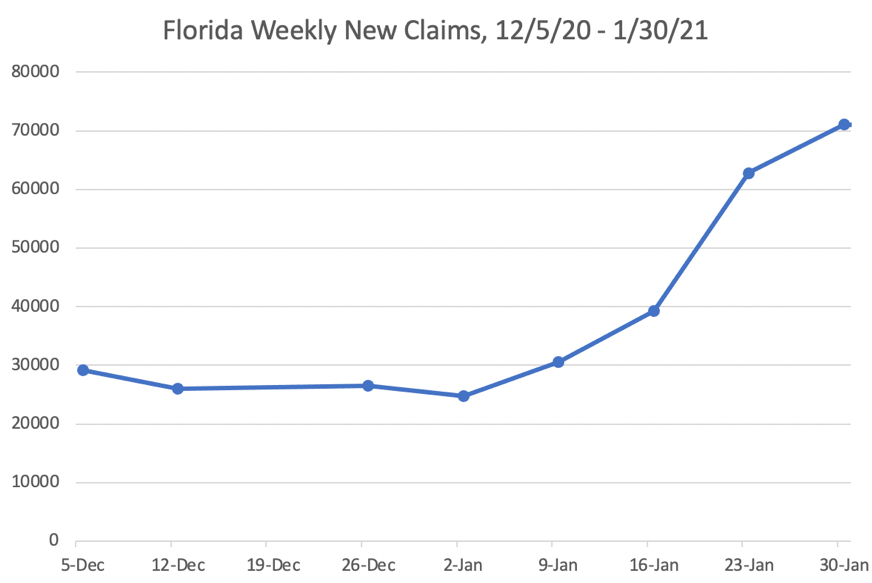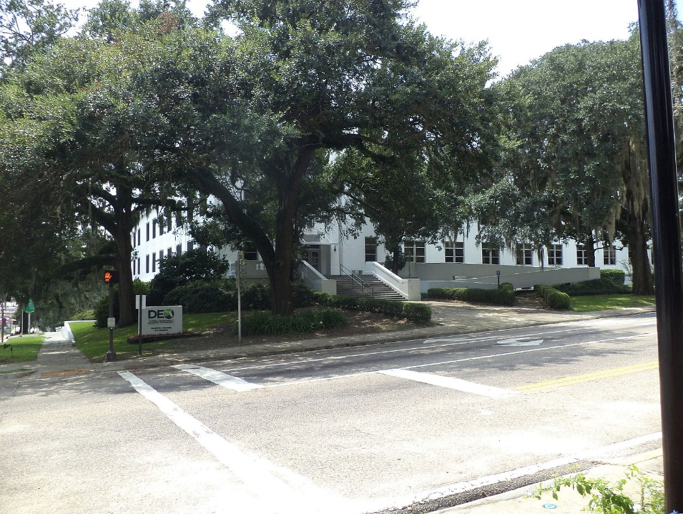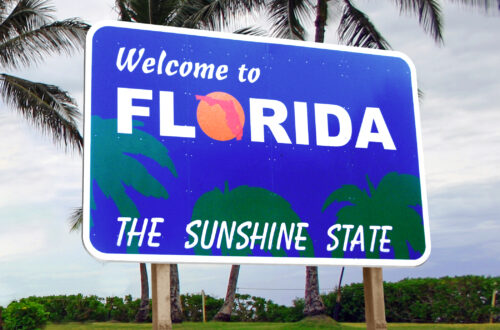The unemployment rate in Florida remains volatile in the wake of the COVID-19 pandemic, with new claims rising and falling periodically as the state’s battered economy recovers in fits and starts.
December 2020 was a month to be optimistic about, with the unemployment rate falling to 6.1%. At a press conference in Key Largo on Jan. 22, Gov. Ron DeSantis, R-Fla., announced that the state had added over 20,000 private sector jobs that month, even as the U.S. as a whole lost jobs in the same period.
“Florida is open,” said DeSantis, crediting the growth to his policy of allowing businesses to remain operational with minimal restrictions in place regarding the ongoing pandemic.
“People have a right to work in Florida, government can’t shut you down, and businesses have a right to operate,” DeSantis said. “I think you’re seeing the results of that.”
The state’s pandemic response has drawn both praise and criticism alike from across the country, with the officials committed to keeping businesses open. DeSantis has also limited the ability of counties and cities to issue restrictions of their own.
He noted that the state’s unemployment rate has fallen below the national average of 6.7%. However, Florida’s unemployment rate does remain slightly higher than the national median of 5.9%, according to state-by-state data from the U.S. Bureau of Labor Statistics.
Despite the upward trends, Florida’s job recovery has been unsteady. While the governor touted 21,100 new private sector jobs, the public sector lost 4,300 jobs as the state continues to suffer with a significant budget shortfall, bringing total new jobs in December down to 16,800.
“Lots of state and local governments are under pressure because many of their revenue streams have dried up,” PNC economist Abbey Omodunbi told the Tampa Bay Times. “It’s hard to make their budget projections due to this pandemic.”
Early relief packages that were passed in 2020 with a Republican White House and Senate prioritized businesses and private employers over state and local governments, but Omodunbi told the Tampa Bay Times thathe anticipates more aid to the public sector with Democrats now holding a narrow trifecta at the federal level.
Tourism, the backbone of the state’s economy, also continues to suffer. The week of Jan. 9 saw unemployment claims more than triple from the previous week to 75,444, due in large part to hotel and restaurant layoffs announced in the third and fourth quarters of 2020 that took effect at the end of the year. However, the Department of Labor revised the Jan. 9 statistic down to 30,583 claims to account for backlogged data.
Nationwide, the leisure and hospitality industry lost 498,000 jobs as cases remain high and the travel industry suffers.
“Most of the jobs affected have been the lower paying jobs,” said Omodunbi. “The front-line leisure and hospitality jobs bore the brunt of this recession.”
The week ending Jan. 23 saw significant losses, as new unemployment claims rose by 47% from 39,226 to 57,824. That number was later revised up to 62,818. It rose sharply again up to 71,046 in the week ending in Jan. 30.

Caption: Despite positive employment growth in December, Florida has seen an increase in new claims in January. Data Sources: Federal Reserve Bank of St. Louis, U.S. Department of Labor (Andrew Taramykin/Florida Political Review).
Furthermore, while December data showed Florida employment trending positive while the rest of the country trended negative, the weekly data for Jan. 23 saw the opposite occur, with Florida being one of just 11 states to see an unemployment increase week-over-week as national first-time claims decreased by 10%.
Sectors that trended positive in December included professional and business services, which added 11,600 new jobs, or transportation and utilities, which rose by 4,800. Both industries saw a near 1% increase in employment that month, per the Tampa Bay Times.
Overall, the state lost 419,000 jobs compared to December 2019, a decline of 4.6%. Although significant, the number is hardly surprising as it reflects a year of unprecedented economic challenges.
From a macroscopic perspective, numbers offer a very mixed assessment of the economic well-being of Florida. Often inconsistent with federal trends, Florida sees sustained growth in some sectors and continuing losses in others as well as unemployment recovery that remains unsteady.
It is also worth noting who is affected by the conflicting patterns—the industries that continue to grow are predominantly white collar, while the industries that suffer employ more working-class Floridians.
As unemployment fluctuations seem to parallel COVID-19 infections, economists conclude that Florida’s economy will not return to its pre-pandemic levels until the vaccine is widely distributed.
“Despite the light restrictions in Florida,” Omodunbi told the Sun Sentinel, “the labor market will remain weak until the vaccine rollout reaches a substantial part of the population.”
Featured Image: Florida Department of Economic Opportunity in Tallahassee. Unmodified photo by Michael Rivera used under a Creative Commons license. (https://bit.ly/2GBOdqz)
Check out other recent articles from the Florida Political Review here.





